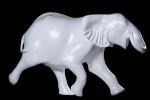Himalayan Thar – Hemitragus jemlahicus
Himalayan Thar – Hemitragus jemlahicus
The Himalayan Thar is a small goat in order of Cetartiodactyla and family of Bovidae. This wild goat is also confused with a sheep lies mainly along the chain of the Himalayas, Kashmir Bhutan in Nepal, although groups of animals were implanted in South Africa and New Zealand. We can observe it at the zoo in Prague, specializing in the preservation of endangered species, but also in the Bois d’Attilly Zoo in Ile-de-France.
The Himalayan Thar has a small head with divergent horns, quite thick at the base. Their length varies from male to female, between 35 and 43 centimeters. The tail is short and ears are small and pointed. The dominant coat color is light brown and it has a thick light colored mane on the neck and shoulders. The rest is darker, reddish to brown by sex and age. The hair on the front are more provided for the male. The weight of an adult is between 35 and 80 kg for a total length of 90 to 130 centimeters.
The Himalayan Thar like living at altitude, up to 5000 meters in summer, above treeline. Agility allows it to climb the steep mountain slopes, near the forest areas.
The Himalayan tahr feeds mainly on plants and it has an active social life. We observe flocks of dozens of animals, the males are absent. Females, about twenty, keep youngs and are escorted by males who are struggling violently during the mating season.
The rut is usually held in the month of December when sexual maturation comes to an end after 2 to 3 years. Gestation is estimated between 180 and 242 days. The female usually gives birth to one or two small, weaning being about 6 months. The life expectancy of an animal is about 15 years.





